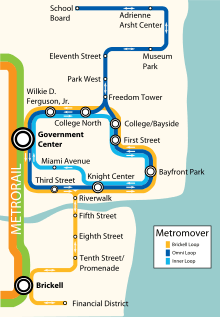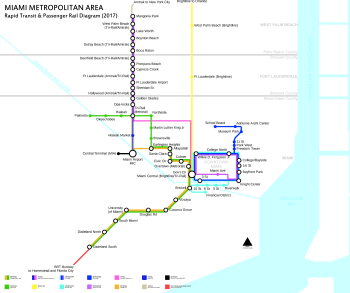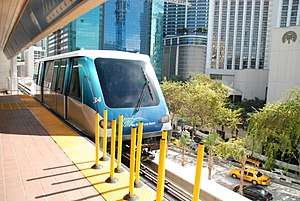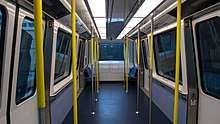Metromover
 A double-unit Metromover train in Omni | |||||||||||||||||||||||||||||||||||||||||||||||||||||||||||||||||||||||||||||||||||||||||||||||||||||||||||||||||||||||||||||||||||||||||||||||||||||||||||||||||||||||||||||||||||||||||||||||||||||||||||||||||||||||||||||||||||||||||||||||||||||||||||||||||||||||||||||||||||||||||||||||||||||||||||||||||||||
| Overview | |||||||||||||||||||||||||||||||||||||||||||||||||||||||||||||||||||||||||||||||||||||||||||||||||||||||||||||||||||||||||||||||||||||||||||||||||||||||||||||||||||||||||||||||||||||||||||||||||||||||||||||||||||||||||||||||||||||||||||||||||||||||||||||||||||||||||||||||||||||||||||||||||||||||||||||||||||||
|---|---|---|---|---|---|---|---|---|---|---|---|---|---|---|---|---|---|---|---|---|---|---|---|---|---|---|---|---|---|---|---|---|---|---|---|---|---|---|---|---|---|---|---|---|---|---|---|---|---|---|---|---|---|---|---|---|---|---|---|---|---|---|---|---|---|---|---|---|---|---|---|---|---|---|---|---|---|---|---|---|---|---|---|---|---|---|---|---|---|---|---|---|---|---|---|---|---|---|---|---|---|---|---|---|---|---|---|---|---|---|---|---|---|---|---|---|---|---|---|---|---|---|---|---|---|---|---|---|---|---|---|---|---|---|---|---|---|---|---|---|---|---|---|---|---|---|---|---|---|---|---|---|---|---|---|---|---|---|---|---|---|---|---|---|---|---|---|---|---|---|---|---|---|---|---|---|---|---|---|---|---|---|---|---|---|---|---|---|---|---|---|---|---|---|---|---|---|---|---|---|---|---|---|---|---|---|---|---|---|---|---|---|---|---|---|---|---|---|---|---|---|---|---|---|---|---|---|---|---|---|---|---|---|---|---|---|---|---|---|---|---|---|---|---|---|---|---|---|---|---|---|---|---|---|---|---|---|---|---|---|---|---|---|---|---|---|---|---|---|---|---|---|---|---|---|---|---|---|---|---|---|---|---|---|---|---|---|---|---|---|---|---|---|---|---|---|---|---|---|---|---|---|---|---|---|---|---|---|---|
| Transit type | Urban people mover | ||||||||||||||||||||||||||||||||||||||||||||||||||||||||||||||||||||||||||||||||||||||||||||||||||||||||||||||||||||||||||||||||||||||||||||||||||||||||||||||||||||||||||||||||||||||||||||||||||||||||||||||||||||||||||||||||||||||||||||||||||||||||||||||||||||||||||||||||||||||||||||||||||||||||||||||||||||
| Number of lines |
Downtown/Inner Loop Omni Loop Brickell Loop | ||||||||||||||||||||||||||||||||||||||||||||||||||||||||||||||||||||||||||||||||||||||||||||||||||||||||||||||||||||||||||||||||||||||||||||||||||||||||||||||||||||||||||||||||||||||||||||||||||||||||||||||||||||||||||||||||||||||||||||||||||||||||||||||||||||||||||||||||||||||||||||||||||||||||||||||||||||
| Number of stations | 21 | ||||||||||||||||||||||||||||||||||||||||||||||||||||||||||||||||||||||||||||||||||||||||||||||||||||||||||||||||||||||||||||||||||||||||||||||||||||||||||||||||||||||||||||||||||||||||||||||||||||||||||||||||||||||||||||||||||||||||||||||||||||||||||||||||||||||||||||||||||||||||||||||||||||||||||||||||||||
| Daily ridership |
33,000 passengers (2016 weekday average) 36,400 (February 2016 peak)[1] | ||||||||||||||||||||||||||||||||||||||||||||||||||||||||||||||||||||||||||||||||||||||||||||||||||||||||||||||||||||||||||||||||||||||||||||||||||||||||||||||||||||||||||||||||||||||||||||||||||||||||||||||||||||||||||||||||||||||||||||||||||||||||||||||||||||||||||||||||||||||||||||||||||||||||||||||||||||
| Website | Metromover | ||||||||||||||||||||||||||||||||||||||||||||||||||||||||||||||||||||||||||||||||||||||||||||||||||||||||||||||||||||||||||||||||||||||||||||||||||||||||||||||||||||||||||||||||||||||||||||||||||||||||||||||||||||||||||||||||||||||||||||||||||||||||||||||||||||||||||||||||||||||||||||||||||||||||||||||||||||
| Operation | |||||||||||||||||||||||||||||||||||||||||||||||||||||||||||||||||||||||||||||||||||||||||||||||||||||||||||||||||||||||||||||||||||||||||||||||||||||||||||||||||||||||||||||||||||||||||||||||||||||||||||||||||||||||||||||||||||||||||||||||||||||||||||||||||||||||||||||||||||||||||||||||||||||||||||||||||||||
| Began operation |
April 17, 1986 (Inner Loop) May 26, 1994 (Outer Loops) | ||||||||||||||||||||||||||||||||||||||||||||||||||||||||||||||||||||||||||||||||||||||||||||||||||||||||||||||||||||||||||||||||||||||||||||||||||||||||||||||||||||||||||||||||||||||||||||||||||||||||||||||||||||||||||||||||||||||||||||||||||||||||||||||||||||||||||||||||||||||||||||||||||||||||||||||||||||
| Operator(s) | Miami-Dade Transit (MDT) | ||||||||||||||||||||||||||||||||||||||||||||||||||||||||||||||||||||||||||||||||||||||||||||||||||||||||||||||||||||||||||||||||||||||||||||||||||||||||||||||||||||||||||||||||||||||||||||||||||||||||||||||||||||||||||||||||||||||||||||||||||||||||||||||||||||||||||||||||||||||||||||||||||||||||||||||||||||
| Technical | |||||||||||||||||||||||||||||||||||||||||||||||||||||||||||||||||||||||||||||||||||||||||||||||||||||||||||||||||||||||||||||||||||||||||||||||||||||||||||||||||||||||||||||||||||||||||||||||||||||||||||||||||||||||||||||||||||||||||||||||||||||||||||||||||||||||||||||||||||||||||||||||||||||||||||||||||||||
| System length | 4.4 miles (7.1 km) | ||||||||||||||||||||||||||||||||||||||||||||||||||||||||||||||||||||||||||||||||||||||||||||||||||||||||||||||||||||||||||||||||||||||||||||||||||||||||||||||||||||||||||||||||||||||||||||||||||||||||||||||||||||||||||||||||||||||||||||||||||||||||||||||||||||||||||||||||||||||||||||||||||||||||||||||||||||
| Track gauge | Automated guideway transit, electric bus | ||||||||||||||||||||||||||||||||||||||||||||||||||||||||||||||||||||||||||||||||||||||||||||||||||||||||||||||||||||||||||||||||||||||||||||||||||||||||||||||||||||||||||||||||||||||||||||||||||||||||||||||||||||||||||||||||||||||||||||||||||||||||||||||||||||||||||||||||||||||||||||||||||||||||||||||||||||
| Average speed | 9 mph (14 km/h) | ||||||||||||||||||||||||||||||||||||||||||||||||||||||||||||||||||||||||||||||||||||||||||||||||||||||||||||||||||||||||||||||||||||||||||||||||||||||||||||||||||||||||||||||||||||||||||||||||||||||||||||||||||||||||||||||||||||||||||||||||||||||||||||||||||||||||||||||||||||||||||||||||||||||||||||||||||||
| Top speed | 31 mph (50 km/h) | ||||||||||||||||||||||||||||||||||||||||||||||||||||||||||||||||||||||||||||||||||||||||||||||||||||||||||||||||||||||||||||||||||||||||||||||||||||||||||||||||||||||||||||||||||||||||||||||||||||||||||||||||||||||||||||||||||||||||||||||||||||||||||||||||||||||||||||||||||||||||||||||||||||||||||||||||||||
| |||||||||||||||||||||||||||||||||||||||||||||||||||||||||||||||||||||||||||||||||||||||||||||||||||||||||||||||||||||||||||||||||||||||||||||||||||||||||||||||||||||||||||||||||||||||||||||||||||||||||||||||||||||||||||||||||||||||||||||||||||||||||||||||||||||||||||||||||||||||||||||||||||||||||||||||||||||
Metromover is a free mass transit automated people mover train system operated by Miami-Dade Transit in Miami, Florida, United States. Metromover serves the Downtown Miami, Brickell, Park West and Omni neighborhoods. Metromover connects directly with Metrorail at Government Center and Brickell stations. It also connects to Metrobus with dedicated bus loops at Government Center and Adrienne Arsht Center (Omni) station. It originally began service to the Downtown/Inner Loop on April 17, 1986, and was later expanded with the Omni and Brickell Loop extensions on May 26, 1994.
The Metromover serves primarily as an alternative way to travel within the greater Downtown Miami neighborhoods. The system is composed of three loops and 21 stations. The stations are located approximately two blocks away from each other, and connect near all major buildings and places in the Downtown area. Together with Metrorail, the system has seen steady ridership growth per annum, with an average of 105,500 daily passengers in 2013.
Out of only three downtown people movers in the United States, the other two being the Jacksonville Skyway and the Detroit People Mover, the Metromover is by far the most successful in terms of ridership, the only completed system of the three,[2] and considered to be a catalyst for downtown development.[3]
History
In 1987, the then-one-year-old people mover system set a record in daily ridership of 33,053 on a Saturday, attributed to the new Bayside Marketplace.[4] That same year was when the planning began to extend the system to Brickell and Omni,[5] which would not be completed until 1994. Until November 2002 when the half-penny transit tax was approved, the Metromover had a fare of 25 cents. The fare was lifted because it was realized that the cost of collecting the fare nearly exceeded the revenue generated from the fare, as well as the fact that more Metromover ridership would likely lead to more Metrorail ridership.[6] After becoming free, from 2002 to 2005, along with a large increase in population, rising gas prices and booming downtown development, Metromover ridership nearly doubled from 4.7 million in 2002 to about 9 million in 2005.[7] However, ridership fell with the subsequent economic downturn and high unemployment in the latter half of the decade. By 2012, ridership had once again increased with downtown population, high gas prices and a recovering economy. In early 2011, Metromover saw an increase in ridership during a sharp peak in gas prices, at the same time as there was a decrease in Metrorail and Metrobus ridership as well as a decrease in employment.[8] However, from January 2010 to January 2011, Metrorail saw a 7% increase in ridership, and both Metrorail and Metromover were expected to see additional ridership increases throughout 2011 due to rising fuel prices.[9] When the Omni and Brickell extensions were first planned, it was estimated that ridership on the fared system would reach 43,000 daily by 2000,[3] a number the now free system has yet to reach.
Operations
There are 21 accessible Metromover stations located throughout Downtown Miami and Brickell roughly every two blocks. The Metromover links all of Downtown and Brickell's major office buildings, residential buildings, hotels, and retail centers. Major attractions such as the Stephen P. Clark Government Center, American Airlines Arena, Arsht Performing Arts Center, the Cultural Plaza (Miami Art Museum, Historical Museum of Southern Florida, Miami Main Library), Bayside Marketplace, Mary Brickell Village, Miami-Dade College, Museum Park(Which services Perez Art Museum Miami as well as the Frost Science Museum) and the Brickell Financial District can all be reached by the Metromover.
Running clockwise, the Downtown (Inner) Loop serves all Downtown stations except Third Street station. The Outer Loop (Brickell and Omni Loops) runs counterclockwise and share tracks around the downtown area, serving all stations except for Miami Avenue Station. The Brickell loop runs a line into the Brickell area to the south of downtown, while the Omni Loop contains a line with stations in the Omni neighborhood north of Downtown. This unusual pattern, a circular central loop where the trains running counterclockwise are those running from and back to destinations outside the loop, whereas trains in the opposite clockwise direction are only running a tight inner circular route, is also followed by the New York JFK Airport AirTrain system. The inner loop generally runs tandem two car trains while the outer loops only run with single cars. Each car can carry over 90 passengers.
The Metromover car maintenance base, unusual for a maintenance yard, is a building located downtown, at SW 1st Ave and SW 1st St, which lies between Government Center and 3rd St stations on the outer counterclockwise loop, at the point where the two loops split to run in adjacent parallel streets.
All loops run from 5 am to just after midnight, from Sunday to Thursday. On Friday and Saturday nights, service is extended until 2 am.[10] This schedule is adjusted during events. Trains on the Inner Loop run in tandem and arrive every 90 seconds during rush hours and every three minutes otherwise. Outer Loop trains arrive every 5 to 6 minutes; every 2.5 to 3 minutes where the track is shared.[6]
The cost of building the system was about $153.3 million. The operating budget for the Inner and Outer (Brickell and Omni) loops in FY 2007 was $8,888,794. Ridership total for FY 2007 was 8.7 million.[11] Not including capital costs, this gives an approximate cost of 1.02 dollars per ride. Metromover does not charge for rides.
Stations


The Metromover currently operates 21 stations, and combined with the Metrorail, the entire Metro system operates 44 stations. Metrorail stations are located at about a mile apart along the line, approximately every two blocks in the greater Downtown Miami area.
Inner Loop
- Government Center
- Wilkie D. Ferguson, Jr.
- College North
- College/Bayside
- First Street
- Bayfront Park
- Knight Center Originally named World Trade Center.
- Miami Avenue Serves Downtown Loop only; all other Inner Loop stations serve all three Metromover loops.
Omni Loop
- School Board
- Adrienne Arsht Center Originally named Omni.
- Museum Park Originally named Bicentennial Park. Closed from October 28, 1996 until the opening of the Perez Art Museum in December 2013.
- Eleventh Street
- Park West
- Freedom Tower
- College North
- Wilkie D. Ferguson, Jr.
- Government Center
- Third Street Originally named Fort Dallas Park; serves both Omni and Brickell Loops.
- Knight Center Originally named World Trade Center.
- Bayfront Park
- First Street
- College/Bayside
Brickell Loop
- Knight Center Originally named World Trade Center.
- Bayfront Park
- First Street
- College/Bayside
- College North
- Wilkie D. Ferguson, Jr. Formerly named Arena/State Plaza
- Government Center
- Third Street Originally named Fort Dallas Park; serves both Omni and Brickell Loops.
- Riverwalk
- Fifth Street
- Brickell City Centre (Eighth Street) Originally called Eight Street; Serves Brickell City Centre
- Tenth Street/Promenade
- Brickell
- Financial District
Fleet


Metromover mainly uses 29 Bombardier Innovia APM 100 vehicles, the first 12 of which were delivered during the summer and fall of 2008.[12] These newer vehicles replaced the first 12 Adtranz C-100 cars which were built by Westinghouse Electric in 1984, and include a more aerodynamic design, as well as an onboard CCTV system.[13] Deliveries of an additional 17 cars from Bombardier Transportation began in July 2010, and as of early 2014 have largely replaced the second order of 17 Adtranz C-100 vehicles, built by Adtranz predecessor AEG-Westinghouse in 1992.
Ridership
Sortable chart detailing monthly weekday ridership averages by Calendar Year; right hand chart giving annual averages may use "fiscal year" without disclosure, where the FY begins in October and has 75% of its time in the next year with only 25% in the starting year. Note the large jump in ridership in 2002 when the fare was removed after the passing of the half-penny tax. Yearly averages are rounded to the nearest 500, and the highest month is also in bold. After years of growth, Metromover ridership began falling in 2017, following years of sharp declines in Metrobus and Metrorail ridership.
| # | Month | 2010 | 2011 | 2012 | 2013 | 2014 | 2015 | 2016 | 2017 | 2018 |
|---|---|---|---|---|---|---|---|---|---|---|
| 1 | January | 27,900 | 29,700 | 28,000 | 31,800 | 32,200 | 32,800 | 34,400 | 32,600 | 28,700 |
| 2 | February | 25,600 | 30,700 | 31,000 | 32,700 | 34,700 | 33,200 | 35,300 | 32,900 | 30,100 |
| 3 | March | 25,600 | 30,500 | 32,400 | 32,500 | 35,300 | 35,000 | 36,400 | 34,100 | 31,100 |
| 4 | April | 26,300 | 30,700 | 29,700 | 30,400 | 31,100 | 32,400 | 34,700 | 31,700 | |
| 5 | May | 26,800 | 29,200 | 28,900 | 28,900 | 30,300 | 29,700 | 32,200 | 29,300 | |
| 6 | June | 25,800 | 29,600 | 29,500 | 32,500 | 30,200 | 30,100 | 31,300 | 28,100 | |
| 7 | July | 25,500 | 29,400 | 29,000 | 29,100 | 30,400 | 30,600 | 32,100 | 29,800 | |
| 8 | August | 26,800 | 29,000 | 27,200 | 28,700 | 31,100 | 31,100 | 30,600 | 28,900 | |
| 9 | September | 28,100 | 30,100 | 29,900 | 31,400 | 31,800 | 32,000 | 32,000 | 24,700 | |
| 10 | October | 30,000 | 31,100 | 31,100 | 33,000 | 33,900 | 35,000 | 31,500[14] | 29,300 | |
| 11 | November | 30,000 | 30,100 | 32,200 | 33,900 | 32,900 | 35,200 | 34,100 | 30,000 | |
| 12 | December | 27,700 | 27,200 | 29,600 | 31,400 | 32,300 | 33,200 | 32,000 | 29,200 | |
| 13 | Year Average | 27,000 | 30,000 | 30,000 | 31,000 | 32,000 | 32,500 | 33,000 |
| Average Weekday Passengers (Metromover loops only) | ||
|---|---|---|
| Fiscal Year | Ridership | %± |
| 1995 | 12,700 | |
| 1996 | 12,000 | -0.6% |
| 1997 | 13,500 | +12.5% |
| 1998 | 13,269 | -1.7% |
| 1999 | 13,880 | +4.6% |
| 2000 | 14,383 | +3.6% |
| 2001 | 16,849 | +17.1% |
| 2002 | 16,444 | 0.0% |
| 2003 | 25,521 | +55.2% |
| 2004 | 28,192 | +10.5% |
| 2005 | 28,473 | +1.0% |
| 2006 | 27,042 | -5.0% |
| 2007 | 28,058 | +3.8% |
| 2008 | 26,682 | -4.9% |
| 2009 | 25,883 | -3.0% |
| 2010 | 27,175 | +5.0% |
| 2011 | 29,775 | +9.6% |
| 2012 | 31,000 | +4.1% |
| 2013 | 32,800 | +5.8% |
Average weekday passengers
This table includes Metrorail ridership as the two systems were built together and are mutually reliant on the thousands of daily transfers at Government Center and Brickell stations.
| Year | Annual passengers (with Green & Orange lines)[15] | Average weekday passengers (with Green & Orange lines)[16] |
|---|---|---|
| 1995 | 18,614,000 | 63,100 |
| 1996 | 18,092,400 | 60,100 |
| 1997 | 18,098,900 | 60,800 |
| 1998 | 17,363,800 | 58,140 |
| 1999 | 17,839,100 | 60,654 |
| 2000 | 18,280,100 | 61,639 |
| 2001 | 18,629,800 | 63,514 |
| 2002 | 19,103,800 | 63,508 |
| 2003 | 21,297,400 | 76,769 |
| 2004 | 24,673,900 | 83,486 |
| 2005 | 25,538,500 | 88,173 |
| 2006 | 25,777,600 | 85,400 |
| 2007 | 26,510,800 | 87,767 |
| 2008 | 27,799,600 | 90,392 |
| 2009 | 25,778,200 | 85,875 |
| 2010 | 25,559,400 | 87,075 |
| 2011 | 27,515,100 | 92,334 |
| 2012 | 28,498,500 | 104,000 |
| 2013 | 30,531,100* | 105,500* |
*Record high
Incidents
- On September 10, 2008, a man was trying to reach his hat that was blown off his head by a gust of wind. While doing so he was struck by a Metromover car.[17]
- On July 21, 2010, two northbound cars collided.[18]
- On February 5, 2014, a man was struck and killed at the Riverwalk Station. Witnesses reported that the man jumped in front of the approaching Metromover car.[19][20]
Expansion
Port of Miami: In May 2011, a study was proposed to analyze the idea of extending the Metromover to the PortMiami. This, with Metrorail and the new MIA Mover would create a direct rail transit link from the airport to the seaport. However, the study, which would take at least a year and cost about $120,000, was only a proposal to be voted on and the idea has not been reported on since 2014.[21]
South Beach: There have been multiple proposals for a Metromover service to southern Miami Beach. One was as part of the proposed Resorts World Miami megaproject in Miami's Omni neighborhood, announced in mid-2011, a Metromover expansion from Downtown Miami to South Beach was being pushed as recompense for building a casino. The line could potentially run from the Omni across the Venetian Causeway to 17th Street in South Beach ending at the Miami Beach Convention Center. The line could have three stations in South Beach along 17th Street- Alton Road, Meridian Avenue and Washington Avenue. This would connect Miami Beach to rail mass transit for the first time, and provide a direct rail connection into one of the Miami area's most visited neighborhoods. The line would also allow for future expansions later across South Beach.[22] More recently, proposals for a separate, most likely at-grade, light-rail system known as BayLink have been revived.[23][24]
SMART Plan: The SMART plan unveiled in 2016 includes a light rail or Metromover expansion to South Beach via MacArthur Causeway, and a north extension to the Midtown area, also serving the Wynwood and Edgewater neighborhoods.
See also
References
- ↑ "Ridership Technical Report" (PDF). Miami-Dade County. July 2016. Retrieved July 14, 2016.
- ↑ Jaffe, Eric (December 8, 2011). "Whatever Happened to the Downtown People Mover?". The Atlantic Media Company. Retrieved 2012-01-11.
- 1 2 "Miami Metromover – The First Automated Downtown Peoplemover in the U.S." University of Washington. June 29, 2008. Retrieved 2012-01-14.
- ↑ Jean Thompson (April 15, 1987). "Bayside Boosts Metromover Ridership". Sun Sentinel. Retrieved 2011-04-02.
- ↑ Tom Lassiter (November 4, 1987). "Metromover Extension Ok'd". Sun Sentinel. Retrieved September 18, 2011.
- 1 2 Gena Holle. "Two of a Kind: Miami's Metrorail & Metromover". Retrieved August 27, 2011.
- ↑ Claudio Mendonça (December 22, 2005). "Metromover ridership doubles in three years". Miami Today. Retrieved 2011-04-02.
- ↑ Ashley D. Torres (February 10, 2011). "Bus and rail use dropped in Miami-Dade County as jobs fell off". Miami Today. Retrieved 2011-04-02.
- ↑ Fabiola Santiago (April 18, 2011). "As gas costs climb, ridership on Metrorail is rising". Miami Herald. Retrieved 2011-04-19.
- ↑ "Metromover". Miami-Dade County. November 17, 2016. Retrieved January 13, 2017.
- ↑ "Metromover Facts". Archived from the original on December 15, 2011. Retrieved December 15, 2011.
- ↑ Blake, Scott (19 March 2014). "Transit tax path still debated". Miami Today News. Retrieved 2014-03-22.
- ↑ Miami Metromover (Bombardier Transportation) Archived November 22, 2008, at the Wayback Machine.
- ↑ "Ridership Technical Report (October 2016)" (PDF). Miami-Dade County. January 2017. Retrieved January 26, 2017.
- ↑ "Ridership Report Archives". Apta.com. Retrieved 2013-07-26.
- ↑ "Ridership Technical Reports". Miami-Dade County. Retrieved March 6, 2017.
- ↑ "Man killed trying to get hat off tracks". Sarasota Herald-Tribune. 11 September 2008. Retrieved 27 December 2015.
- ↑ "Inquiry launches into Metromover crash". SunSentinel. Retrieved 27 December 2015.
- ↑ "Person Killed By Metromover In Downtown Miami". CBSMiami. Retrieved 27 December 2015.
- ↑ "Man killed after fatal Metromover accident". 7 News WSVN. Archived from the original on December 30, 2015. Retrieved December 27, 2015.
- ↑ Alfonso Chardy (May 15, 2011). "Metromover extension to Port of Miami proposed". Miami Herald. Retrieved September 17, 2011.
- ↑ "Beach Taxpayer's Association features forum on casino plan | Belle Isle Blog". Belleisleblog.wordpress.com. 2011-10-04. Retrieved 2013-07-26.
- ↑ Garvin, Glenn (July 8, 2014). "Rail link between Miami, Miami Beach likely to be private-public affair". Miami Herald. Retrieved August 29, 2014.
- ↑ Blake, Scott (June 4, 2014). "Public-private transit projects planned". Miami Today. Retrieved August 29, 2014.
External links
Route map:

- Metromover on Miami-Dade County's official website
.jpg)